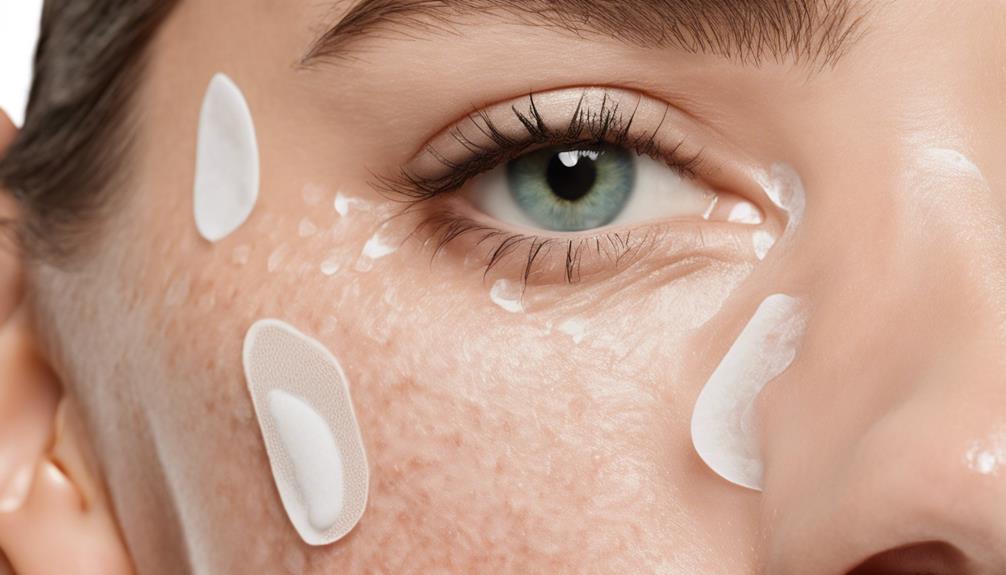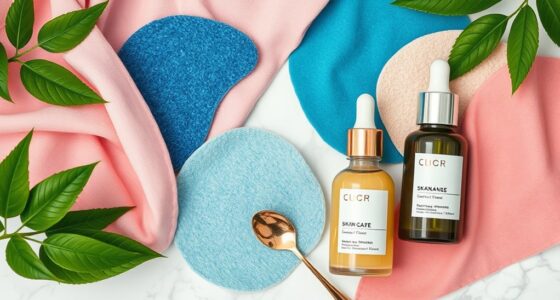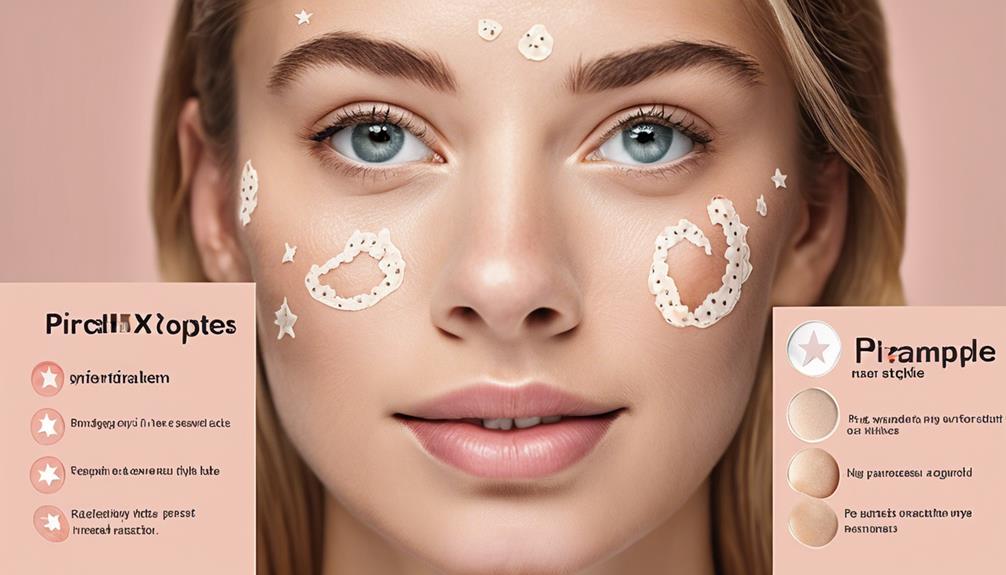Pimple patches absorb pus thanks to their hydrocolloid material, which creates a gel-like barrier that pulls fluids from your skin. This moisture-retaining layer helps shrink pimples while protecting them from external irritants. It keeps the area moist, promoting faster healing and reducing the chance of scarring. Plus, the patches deter you from picking, which can worsen the situation. Interested in discovering more about how these patches work and their benefits?
Key Takeaways
- Hydrocolloid patches are made from polymers that absorb fluids like pus, reducing pimple size and redness effectively.
- The gel-like consistency forms a protective barrier that keeps the environment moist, enhancing the healing process.
- By isolating the pimple from external contaminants, patches prevent bacterial growth and irritation during the healing phase.
- Moist environments created by the patches promote faster absorption and tissue repair, crucial for diminishing inflammation.
- Pimple patches should be applied to clean, dry skin and replaced when saturated for optimal absorption of pus.
The Science Behind Hydrocolloid Material

When you consider the effectiveness of pimple patches, the science behind hydrocolloid material plays a crucial role.
Hydrocolloid is a blend of long-chain polymers, like gelatin and pectin, that absorbs water to form a gel. When you apply a hydrocolloid patch to a pimple, it absorbs pus and oil, reducing size and redness while creating a protective barrier. This gel-like substance maintains a moist environment that prevents bacterial growth and irritation from daily activities. The flexible film often supports the patch, enhancing comfort and adhesion. Additionally, hydrocolloid patches are designed to absorb excess fluid from acne lesions, which contributes to their effectiveness in treating pimples. With its biocompatibility, hydrocolloid is ideal for acne treatment, providing an effective solution while promoting healing without exposing the area to air or contaminants.
How Pimple Patches Promote Wound Healing

Hydrocolloid patches not only absorb fluids but also play a significant role in promoting wound healing for acne lesions. They effectively absorb pus and oil, reducing the size and redness of your pimples. By acting as a barrier, these patches protect your skin from external contaminants, lowering the risk of infection and inflammation. They maintain a moist environment, which speeds up healing and minimizes scarring, ultimately enhancing overall effectiveness. Plus, by covering the pimple, patches deter you from picking or popping, further preventing irritation. With all these benefits combined, you’ll notice that these patches can accelerate the healing process, flattening pimples overnight and helping your skin recover more efficiently.
Types of Pimple Patches and Their Functions

There are several types of pimple patches available, each designed to tackle acne in different ways.
Hydrocolloid patches absorb fluids and create a protective barrier, making them ideal for pus-filled pimples. This allows for effective absorption of exudate, promoting a moist healing environment.
Medicated patches, infused with salicylic acid or tea tree oil, help reduce inflammation and clear bacteria.
For deeper skin penetration, microneedle patches use tiny spikes to deliver active ingredients more effectively.
Most patches are made from breathable materials, preventing overheating while they work.
Most pimple patches use breathable materials to ensure comfort and prevent overheating during treatment.
Remember, these patches are disposable, so replace them once saturated.
Each type offers unique benefits, catering to various acne types, and ensuring you have the right option for your skin’s needs.
The Role of Moist Environments in Absorption

Moist environments play a significant role in the absorption process of pimple patches, enhancing their effectiveness in treating acne. The hydrocolloid material in these patches creates a moist setting that helps absorb pus and fluid from your pimples. Hydrocolloid technology promotes faster healing by allowing the patches to maintain a hydrated environment, which is crucial for effective absorption. As the hydrocolloid gel swells and turns opaque, it signals effective absorption. This concept, rooted in wound care, promotes tissue repair while preventing bacterial growth by isolating the pimple from external contaminants.
The hydrated environment supports faster healing and maintains ideal conditions for skin recovery. By ensuring moisture levels remain consistent, these patches effectively absorb excess fluid, reduce inflammation, and create a protective barrier that keeps the surrounding skin safe from infection.
Benefits of Using Pimple Patches for Acne

When you’re dealing with acne, the convenience and effectiveness of pimple patches can be a game-changer. They’re simple to apply, targeting specific blemishes without affecting the surrounding skin. With their thin and transparent design, you can wear them discreetly during the day or overnight. Pimple patches act as a protective barrier, reducing the urge to pick at pimples while shielding them from bacteria and pollution. This helps minimize inflammation and promotes natural healing. Their hydrocolloid properties absorb excess fluid, drawing out impurities and accelerating the healing process. Plus, many patches contain soothing ingredients like tea tree oil, calming irritation and reducing redness. Hydrocolloid patches create a moist environment that aids in healing, making them even more effective in treating blemishes. Incorporating pimple patches into your routine can be a smart strategy for managing acne effectively.
Limitations and Considerations for Effective Use

While pimple patches can be effective tools for managing acne, it’s vital to recognize their limitations and consider how to use them properly.
Pimple patches are helpful for acne management, but understanding their limitations is key to effective use.
These patches work best on open or early-stage pimples, but they won’t penetrate deep cystic acne. Be cautious of potential skin irritation from adhesives, and remember that covering pimples could trap bacteria. Additionally, relying on patches may worsen skin conditions if not used appropriately.
Overreliance on patches might delay seeking professional help for severe acne, leading to more issues. Always apply patches to clean, dry skin and avoid leaving them on too long.
Finally, don’t expect them to address underlying causes like hormonal imbalances or diet; a thorough skincare routine and professional guidance are essential for long-term success.
Frequently Asked Questions
How Long Can I Wear a Pimple Patch?
You can typically wear a pimple patch for 6-8 hours to effectively absorb impurities and reduce inflammation.
If you’re treating stubborn pimples, wearing it overnight for 8-12 hours is ideal.
Some patches are designed for extended wear, lasting up to 24 hours, but check them regularly to verify they aren’t saturated.
Always remove the patch once it’s full for the best results, and follow up with your regular skincare routine.
Can I Use Makeup Over Pimple Patches?
Imagine your skin as a canvas, and pimple patches as your protective layer, ready to work their magic.
Yes, you can use makeup over pimple patches! Just remember to keep it light and gentle.
Opt for ultra-thin patches that blend seamlessly, and liquid products that won’t disturb them. A fluffy brush or sponge can help you apply makeup softly.
With care, you’ll keep your skin healing while looking fabulous.
Are Pimple Patches Reusable?
No, pimple patches aren’t reusable.
Once you apply one, it absorbs pus and oil, making it a single-use product. Reusing patches can introduce bacteria back to your skin, leading to infections or more breakouts.
To keep your skin healthy, always discard used patches after they’ve done their job. You can apply a fresh patch as often as needed on clean, dry skin for the best results in treating your blemishes.
Do Pimple Patches Expire?
Yes, pimple patches can expire.
Hydrocolloid patches generally last for about three years, while those with active ingredients like salicylic acid have a shorter shelf life due to ingredient degradation.
To guarantee they work effectively, store them away from sunlight and moisture.
Always check the packaging for expiration dates, especially for medicated patches.
Using expired patches might lead to reduced effectiveness or even irritation, so it’s best to use them within a reasonable timeframe.
Can I Use Pimple Patches on Open Wounds?
You shouldn’t use pimple patches on open wounds, especially if they’re infected.
These patches work best on clean, non-infected acne blemishes. They provide a protective barrier and absorb excess fluids, but applying them to open wounds can trap bacteria and worsen the situation.
If you’ve popped a pimple, make sure it’s clean and free from infection before applying a patch. Always prioritize proper wound care for ideal healing.
Conclusion
So, you thought pimple patches were just a trendy gimmick? Surprise! These little wonders harness hydrocolloid technology to create a moist environment that not only absorbs pus but also promotes healing. While they won’t turn back time on your skin’s history, they certainly offer a surprisingly effective way to tackle those pesky breakouts. Just remember, they’re not a miracle cure—more like a stylish band-aid for your acne woes. Who knew treating blemishes could be so… satisfying?










